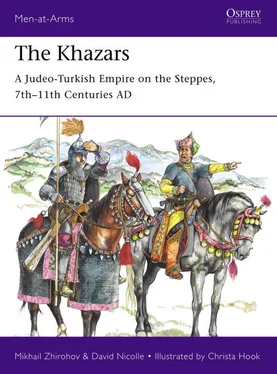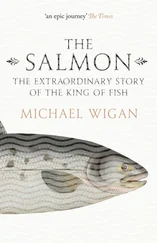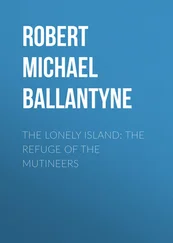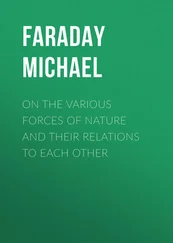The degree of metallurgical and technological sophistication achieved by the still largely nomadic Khazars in the 7th century might suggest some (perhaps considerable) influence from south or east of the steppes. However, in the Byzantine, Iranian, early Islamic or even Chinese empires there is still little archaeological evidence for such features as plate shoulder defences (pauldrons), greaves with applied ‘splints’, or ‘loose-riveted’ lamellar armour◦– but all these features are shown here. Khazar wealth is suggested by the gilded front plate of his directly riveted segmented helmet. His full panoply consists of a single-edged straight sword with a curved hilt, in a brass-fitted scabbard with ‘D’-shaped projections for suspension; a spear with a two-tailed pennon; a leather-covered wooden shield with an iron boss; a composite bow carried unstrung in a brightly painted case; plus (obscured here) a quiver to carry arrows points uppermost, and a large fighting knife or khanjar perhaps made en suite with the sword. This impressive level of equipment would also become typical of some neighbouring cultures, not least the Islamic Caliphate. His horse is protected by full lamellar armour including a chamfron, and a red-dyed horsetail tassel hangs below the bridle. The saddle is of the fully wood-framed type long known among many Inner Asian nomads and the Chinese, and the harness now includes iron stirrups.
B2: Sabirian armoured cavalryman, 6th–7th centuries
This Sabir (Savir) tribal warrior illustrates the sophistication achieved by the Khazars’ immediate predecessors north of the Caucasus. His helmet consists of four large segments riveted to vertical framing and joined beneath a crowning dome; like B1’s, it has ‘eyebrows’ with a nasal bar and an attached ringmail aventail, while lacking a brow-band. His substantial cuirass and upper arm defences are of iron lamellae laced with rawhide thongs, leaving only his forearms and his lower legs in soft leather boots unprotected. His archery equipment is of a form seen across most of the Eurasian steppes, while his single-edged sword is still straight. The apparent tassels hanging from his horse’s crupper strap may be the hair of defeated and captured foes, while just visible hanging from the breast strap is one of a pair of bright bronze discs with simple images of human faces, which may recall earlier head-hunting practices.
B3: Western steppes nobleman, 7th century
Just visible in the background is a rider in everyday dress, from one of a number of ‘relic populations’ left in what is now Ukraine and some neighbouring areas after the great migrations of the 4th–5th centuries. Perhaps Slavic or Germanic, his general appearance and clothing look European rather than from a nomadic steppe culture, but his sword, archery equipment and horse harness show strong Iranian influence.
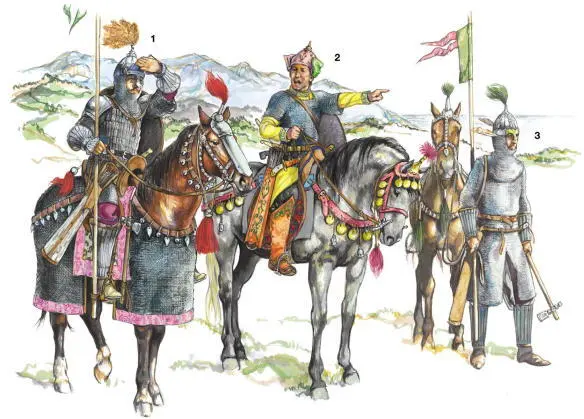
1: Khazar heavy cavalryman, 9th C
2: Alan cavalryman, late 9th–early 10th Cs
3: Kabarian cavalryman, late 9th–early 10th Cs
C1: Khazar heavy cavalryman, 9th century
At the highpoint of Khazar power the elite of fully armoured cavalryman wore almost as much armour as later medieval Western European men-at-arms. This included a segmented iron helmet with a substantial nasal bar, mail aventail and plumed spire; a half-sleeved, long-hemmed mail hauberk, under an iron lamellar cuirass laced with rawhide thongs; substantial iron shoulder plates; splinted ‘bell-topped’ iron gauntlets, and similar splinted iron greaves. Prepared for close combat with spear, shield, sword, fighting knife, and a battle-axe slung by a leather loop at the front of his saddle, this man also carries full archery equipment. His horse has a mail trapper and a limited form of iron chamfron consisting of two elements riveted together, but lacks neck protection. Note the lavishly ornamented and tasselled harness, and (just visible under his leg) the panel of spotted animal-pelt over the patterned silk saddle-cloth.
C2: Alan cavalryman, late 9th–early 10th century
The Alans of the Caucasus were descended from Iranian rather than Turkish-speaking nomadic steppe peoples. Now settled and seemingly prosperous, they survived centuries of nomadic invasion and conquest, adopting religions and elements of military style from their more powerful neighbours, but also retaining some distinctive features of their own. Among these were quilted hats or hoods, sometimes highly decorated, of which the lower part could be turned up as shown here. This mail-clad rider is equipped as a relatively lightly armoured horse-archer, with both sword and battle-axe for close combat. The abundance of decoration on his own gear and his horse’s harness, the latter including tufts, bronze discs and silver bells, seems more suited to a festive occasion than to battle.
C3: Kabarian cavalryman, late 9th–early 10th centuries
There appear to have been significant variations in the military equipment and combat styles of different peoples across the sprawling Khazar Khaganate. Though of nomadic Khazar origin, the Kabarians of the west soon looked almost European, with their reliance on mail rather than lamellar armour. The iron vambraces and greaves shown here, consisting of simple iron splints riveted to leather linings, nevertheless remained characteristically Khazar, as is his segmented helmet adorned with a tuft and side-feathers. The man’s weaponry, including full horse-archery equipment, spear, sword and axe, and his horse harness, are fully within a steppe tradition which would itself profoundly influence subsequent medieval Russian styles.
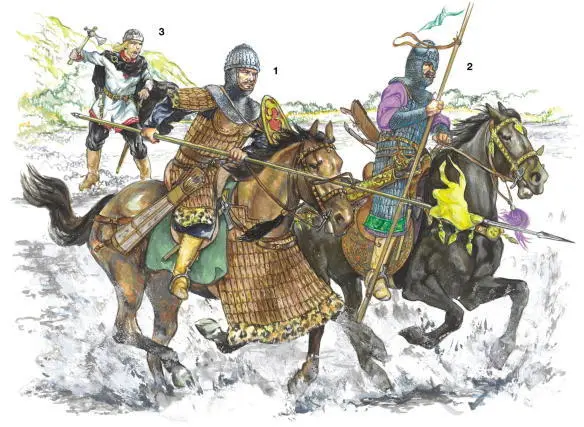
1: Turkic armoured cavalryman, 7th C
2: Magyar nobleman, late 9th–early 10th Cs
3: Slavic tribal leader, 9th C
D1: Turkic armoured cavalryman, 7th century
Various Turkic nomadic peoples inhabited the steppes to the east of the Khaganate, occasionally dominated by, or fighting either for or against the Khazars. Their military equipment had by now evolved into forms which would remain largely unchanged for centuries. The only unusual and perhaps old-fashioned aspect of this man’s armour is the double rounded breast protection made of sewn layers of rawhide. Otherwise it consists of a rawhide lamellar cuirass and upper arm defences, and a substantial mail aventail hanging from a helmet made of multiple scallop-shaped vertical splints laced together. Although he wields a two-handed lance he also carries a small round shield. The limited horse armour, protecting only the breast, is also of rawhide lamellar construction; like the rider’s cuirass, it is edged with spotted fur, perhaps leopard-skin.
D2: Magyar nobleman, late 9th–early 10th centuries
The Magyars who inhabited the steppes along and beyond the western frontiers of the Khaganate played a significant role in Khazar military history, and it is not surprising that their equipment had much in common with that of the Khazars. Yet they too also showed some distinctive features, not only in the decoration of weapons and horse harness but notably in their use of advanced forms of helmet. This example has an unusual, rather blunt-domed shape but is still made of large, directly riveted segments, with an iron nasal on a brow plate with three vertical extensions. (Within a few decades many of those Magyars who migrated further west into what became Hungary had helmets forged from a single piece of iron.) In addition to a full mail hauberk worn beneath his woollen coat, this nobleman also has a traditional iron lamellar cuirass with rawhide lacing, reaching to his knees above fancy-cut soft leather boots fastened with buckles. His weapons include spear, sabre, archery equipment with both a strung and an unstrung bow in two cases, and an axe hanging from his saddle.
Читать дальше
